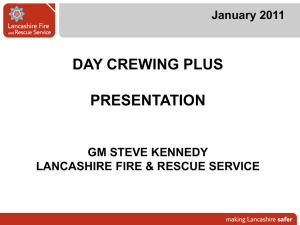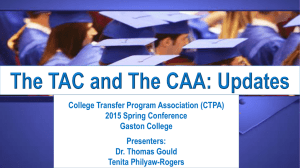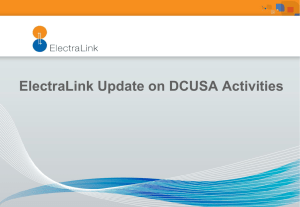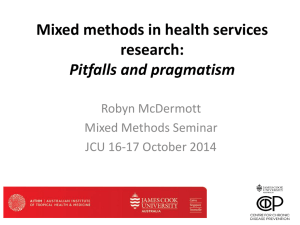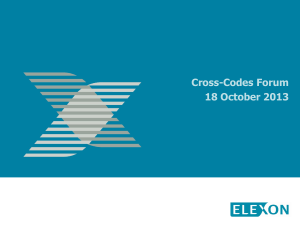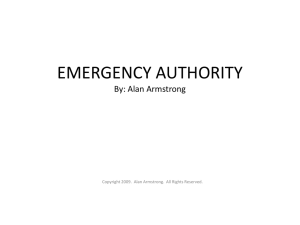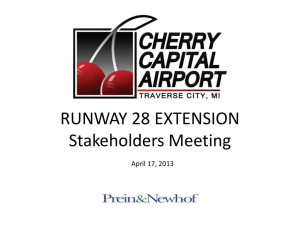Presentation
advertisement
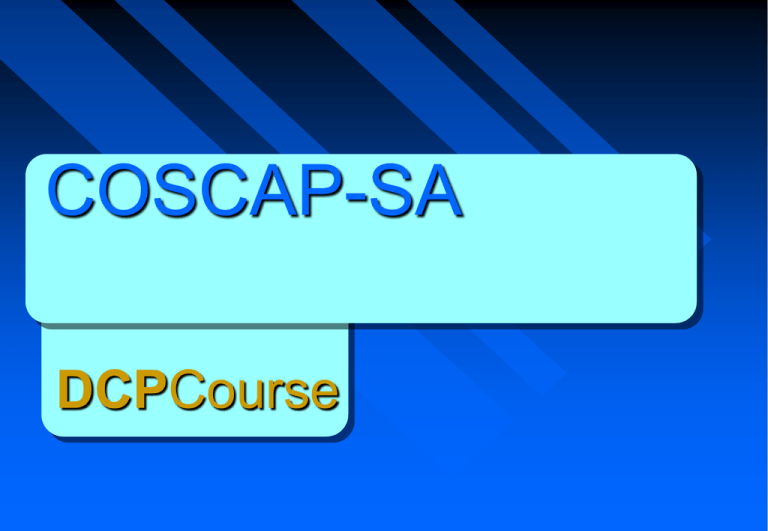
COSCAP-SA DCPCourse Course Objectives Validate DCP authority Promote standardization Review standards and procedures Review flight testing procedures Course Schedule Introduction ICAO SARPS General Conditions DCP Qualifications DCP Terms of Reference Course Schedule (con’t) Principles of Testing Principles of Assessment Conducting a PPC PPCTolerances Assessment Scenarios Discussion Groups Course Schedule Introduction ICAO SARPS General Conditions DCP Qualifications DCP Terms of Reference Introduction Course Instructor: Captain Len Cormier COSCAP-SA . Participation . Tea Break . Promptness . Washrooms …..enjoy the course Course Schedule Introduction ICAO SARPS General Conditions DCP Qualifications DCP Terms of Reference ICAO SARPs Annex 6, 9.4.4 - Pilot Proficiency Checks – An operator shall ensure that piloting technique and the ability to execute emergency procedures is checked to demonstrate competency – If under instrument flight rules the pilot’s competence to comply with such rules is demonstrated – Either a check pilot of the operator or to a representative of the State of the Operator – Performed twice within any period of one year.. ICAO Guidance DOC 8335 - Pilot Proficiency Checks – when properly controlled by the CAA, the designation of qualified operator personnel to assist in some inspection functions, such as periodic pilot proficiency checks, route checks, etc., can be acceptable – it must be stressed that the designated operator personnel, when performing their duties, must be kept under the supervisory and technical control of the CAA. ICAO Guidance DOC 8335 - Pilot Proficiency Checks – Proficiency checks are carried out in accordance with the standards and frequency prescribed in the regulations – The CAA inspector should possess the appropriate licence and be currently qualified in the specific type of aircraft to be used for the check – Alternatively, the CAA inspector may choose to observe or monitor such checks conducted by an appropriately designated check pilot ICAO Guidance DOC 8335 - Pilot Proficiency Checks – The CAA inspector should observe or monitor a sufficient number of checks conducted by such personnel each year in order to ensure positive CAA quality control of check procedures – The pilot proficiency check should be conducted in such a manner that the pilot demonstrates knowledge, skill and judgment relative to: – the aircraft, its systems and components; – pilot performance in accordance with the procedures and limitations contained in the manufacturer's AFM, AOM, Operations Manual, etc. Course Schedule Introduction ICAO SARPS General Conditions DCP Qualifications/Adm DCP Terms of Reference General Conditions Delegation Policy – Perform checks on behalf of CAA – Restricted to certain checks – Approved by CAA General Conditions Conflict of Interest (Perceived or real) – Financial interest in the company or family ties – Privileges or favors which could bias DCP – Company to review and advise CAA – To avoid a real conflict of interest, imperative to adhere to DCP Manual Course Schedule Introduction ICAO SARPS General Conditions DCP Qualifications/Adm DCP Terms of Reference DCP QUALIFICATIONS CURRENCY & TRAINING REQ’TS – a DCP must hold a valid ATPL with rating endorsed on type – a DCP must have completed an DCP Course – attend a refresher DCP Course every 5 yrs – conduct at least 10 checkrides a year – 1000 HRS PIC on appropriate aeroplanes -500hrs on type (Type A) – Minimum of six months experience as Line Captain on the aircraft DCP Qualifications cont’d Loss of Medical – advise CAA – perform checks in simulator only – complete requirements of training programme – every 6 months monitor four sectors DCP Administration DCP Approval Monitoring DCP Air Operator Responsibilities DCP Approval DCP Application from air operator Determine need for DCP – – – – number/variety of aircraft location of bases/simulators type of operation number of DCPs employed DCP Approval Inspector briefings – – – – – procedures/techniques for checks techniques/standards for assessment briefing/debriefing procedures completion of forms contents of publications DCP Approval Monitoring DCP – – – – Initial DCP Monitors (2), Conducts (1) Conduct 12 month PPC on Type A DCP Monitoring DCP conducting check every 12 month Monitoring activities (reports, etc.) DCP Approval Air Operator Responsibilities – – – – – Monitor DCP validity Maintain records for audit purposes Monthly schedule to CAA Advise CAA of due dates Submit check report to CAA Limits of Authority Recurrent PPC Recurrent IRT Line Checks Line Indoc 1200/600 RVR T/O Cat 2/ Cat 3 Ops . Limits of Authority Semi-annual PPC on Supervisor Retest of failed PPC/IRT (CAA advised) Recurrent Trng/Checking with approval Not Allowed: – initial or upgrade training followed by check by same individual; – DCP conducting check ride on Inspector THE APPENDICES A. Nomination Form B. DCP Approval C. Pilot’s Line Check Report D. Schedule of Flight Checks E. Check Pilot Monitoring Report F. Sample Check Pilot Report G. Summary of PPC Standards Professional Update GPS-Operations -Requirements -Testing -Approaches -Differential GPS RNAV-Direct Routes -Certification -Approaches FMS-FACF -Approaches Approach Changes GPS Operations Short Term - Non-Precision approaches - Domestic enroute/terminal - Oceanic Long Term - CAT I approaches - Possibly CAT II and III IFR Approval - US and Canada concurrently GPS Requirements With RAIM: - use GPS for "overlay" and "standalone" - conventional navaids must work at alternate - MNPS requirements - 1 GPS and 1 other RNAV system - need a TSO C129 receiver - no need to monitor navaids Without Raim: - must monitor navaids - not approved for IFR RAIM: - Receiver Autonomous Integrity Monitoring GPS OVERLAY APPROACHES approach to use published name (NDB 24) approach must be in database no monitoring required (with RAIM) NAVAIDS and a/c receivers operating GPS STANDALONE APPROACHES requested and approved as GPS approach (GPS 24) RAIM must be available ground-based navaids at destination can be inoperative but navaids at alternate operative Differential GPS Wide area Local Integrity and availibity Accuracy Professional Update Designated Check Pilot Course NAVIGATION WEATHER AIRSPACE RNAV Direct Routes RNAV Direct Routes Presently 3 types of route are available: 1) Random direct FL 390 and above 2) City pair T-routes FL 310 and above 3) *MMT routes FL 350 - FL 390 Random routes to be available in future * MMT-Minimum Time Track RNAV Approaches Multi-Sensor RNAV RWY 08 YTZ Certification of receivers a problem All approaches could be RNAV Type of sensor - determine limits All info must be in database * *and operator certified for use FMS FACF FINAL APPROACH COURSE FIX Required by FMS databases On final about 8 NM from threshold Prior to vnav/FAF ICAO 5-letter pronounceable name For all ILS and LOC approaches FMS Approaches Database : Jeppesen Types of FMS Approaches: GPS RNAV VOR,VOR/DME NDB,NDB/DME LOC/BC LOC ILS with advanced EFIS Approach Changes NAME CHANGES soon to be RNAV and then MDA will be based on the type of sensor POSITION REPORTS During approaches at controlled airports - Make requested reports only - Report position only - Expect report at FAF Approach Changes Pass altitude on departure - Initial call add passing altitude and give cleared altitude If pilot cannot make an altitude restriction: - Pilot actions: • ask for instructions • enter hold if no instructions - Controller actions: • protect holding airspace Course Schedule 1/2 Introduction Forms and Administration DCP Quals/Reqts/Terms Canadian Aviation Regs Instrument procedures Instrument Procedures 1 Outline 1. Flight Planning 2. Departure 3. Enroute 4. Holding 5. Arrival 6. Approach 7. Missed Approach 8. Circling 9. Landing Instrument Procedures 1 Outline 1. Flight Planning 2. Departure 3. Enroute 4. Holding 5. Arrival 6. Approach 7. Missed Approach 8. Circling 9. Landing Definitions Shall: Imperative, procedure is mandatory Will: Mandatory, comprehensive, and dispositive in nature Must: Primarily mandatory, not the only meaning, used for both permissive and mandatory sense May: Speculation, uncertainty, permissive Should: Implying duty of obligation, also permissive Practical: Available or useful in practice - inclined or suited to action rather than speculation Practicable: Physically possible The above definitions are summarized/paraphrased from Black's Law Dictionnary except "Practical" which was copied from the Concise Oxford Dictionary. New Altimeter Error Policy "An aircraft altimeter which has the current altimeter setting applied to the subscale should not have an error of more than ±50ft when compared on the ground against a known aerodrome/runway elevation. If the error is more than ±50 ft the accuracy of the altimeter is questionable and the problem should be investigated." (CAP.GEN) Fly Runway Heading When instructed to fly runway heading or when flying a SID for which no specific heading is published, pilots are expected to: • Fly runway heading • Do not apply drift correction • FMS fly track Standard Climb Gradient Obstacle Clearance after T/O VFR climb (Y/N) Departure procedure(Y/N) Missed approach procedure(Y/N) Sector altitudes(Y/N) Topo maps or local knowledge(Y/N) SID- pilot and nav Holding Pattern Max Holding Speeds Jet Prop Turbulence - 14K and below - above 14 K - in climb - 230 kt - 265kt - 175 kt - 175 kt - 280kt/ Mach .80 Instrument Procedures 2 Outline 1. Flight Planning 2. Departure 3. Enroute 4. Holding 5. Arrival 6. Approach 7. Missed Approach 8. Circling 9. Landing Speed Limits 200kts below 3,000 ft within 10 NM of tower 250 kts below 10,000 ft (exemptions) * Minimum IFR Alttudes (Controlled Airspace) a) Minimum Enroute Altitude (MEA) b) Minimum Obstruction Clearance Altitude (MOCA) c) Geographic Area Safe Altitude (GASA) d) Minimum Sector Altitude (MSA) e) Safe altitude 100 NM f) Minimum vectoring altitude g) Transition altitude * ATC is not permitted to approve or assign any IFR altitude below the minimum IFR altitude Altitude Correction Chart A/D Height above the elevation of the altimeter Source 200 300 400 500 600 700 800 900 0o 0 20 20 20 20 40 40 40 -10o 20 20 40 40 40 60 80 80 -20o 20 40 40 60 80 80 100 120 -30o 40 40 60 80 100 120 140 140 -40o 40 60 80 100 120 140 160 180 -50o 40 80 100 120 140 180 200 220 Temp oC Note: Values should be added to published altitudes Altimeter Settings Requirements Before commencing an IFR approach, set current altimeter setting Altimeter setting can be local or remote Readings are considered current for up to 90 minutes If pressure falling rapidly, may add value to published DH/MDA Correction factor to be applied for remote altimeter source *Temperature correction to be applied in all cases Visual Approach VFR approach while on IFR flight plan Weather - VFR (300m- 5km) ATC may give radar vectors to gain operational advantages Weather - ceiling 200m above min vector altitude - ground vis at least 5 km Condition: pilot shall be in visual contact with the airport and/or traffic Pilot is responsible for: - Wake turbulence separation - noise abatement - Obstacle clearance Cleared for an Approach Cleared for an approach Can fly any published inst. approach Can descend to minimum IFR altitudes Three route options: - cleared route - transition - direct Must advise ATC which route and approach Straight-In Approach No PT published straight-ins ATC radar-vectored straight-ins Can not do straight-in otherwise Aircraft Approach Category Category Speeds A UP to 90kt B 91kt120kt C 121140kt D 141165kt E Above 165kt All rotocraft are Category A Use speed flown on approach to determine category Use Minima for category flown Glidepath Fails During ILS Advise ATC Determine new minima Change beacon X-ing alt Time and descent rate to MDA If in doubt, overshoot Light Settings and RVR RVR readouts compensate for the setting of the runway edge lights. At setting 5 the RVR will give the highest reading. This will affect the RVR readout even if the runway lights are off. ATC should advise pilots when the runway light intensity is at setting 4 or 5. Missed Approach During Circling Commence climb Advise ATC Turn toward airport (normally) Fly published procedure Use local knowledge and plate to make a safe procedure Circling Approach Area Radii Approach Category A B C D E Radius (Miles) 1.3 1.5 1.7 2.3 4.5 • Keep runway in sight • Stay at MDA until normal landing assured Landing Minima Landings are governed by published DH/MDAs. Pilots of aircraft on instrument approaches are prohibited from continuing the descent below DH or MDA, unless the required visual reference is established and maintained in order to complete a safe landing. Visual References At least one of the following: a) The runway or runway markings; b) The runway threshold or threshold markings; c) The touchdown zone or touchdown zone markings; d) The approach lights; e) The approach slope indicator system; f) The runway identification lights (rils); g) The threshold and runway end lights; h) The touchdown zone lights; i) The runway edge lights; or j) The runway centreline lights. Harvard Mk.iv Questions?
